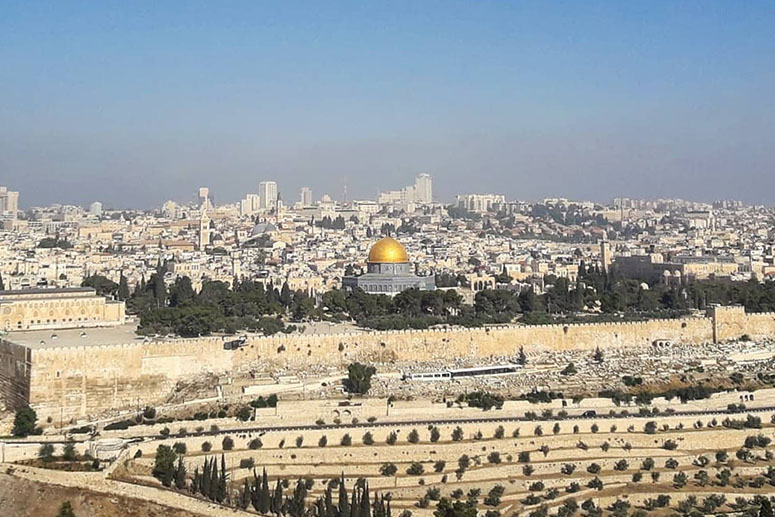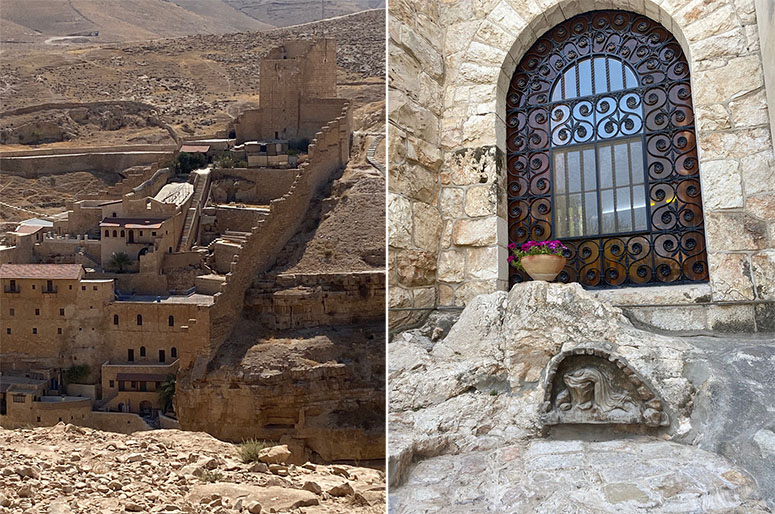Beyond Jerusalem: Antiquities and desert
So much has been and will be written about Jerusalem. It is the center of every visit to Israel, whether pilgrimage or vacation. And there is more than enough in Jerusalem to satisfy every curiosity and quest for history and religiosity.
Start from the Mount of Olives for a panorama of the old city. On the way down stop in at the serene Garden of Gethsemane and the Church of All Nations; then you will be ready to enter the City of David through any of the seven gates and confront your faith (or lack of it) – the Western Wall, all that remains of the Second Temple; the Dome of the Rock, the Via Dolorosa and finally the Church of the Holy Sepulcher. These are to be experienced rather than read about; my words will not ever come close to what it is like to walk those centuries-old stones and have the walls whisper their stories and secrets.

One of the “modern” attractions of Jerusalem today is the Israel Museum, with the most extensive collection of biblical and Holy Land archeology in the world. Its crown jewel is the Shrine of the Book, a unique white domed building that features an exhibit on the Dead Sea Scrolls, the most important archeological discovery in the Holy Land. Ancient Jewish and Hebrew manuscripts were discovered by bedouins between 1947 and 1956 in 11 caves in Qumran, on the northwestern shores of the Dead Sea. Over 800 documents on papyrus, animal skin and even copper include fragments from every book of the Old Testament, except for the Book of Esther. The Shrine of the Book is the repository for the first seven scrolls discovered; others are in the Jordan Museum in Amman.

You enter the exhibit area through a cave-like tunnel. It is, of course, a temperature, humidity and light controlled environment, and taking of photographs is not allowed (the custodian is on your case the instant you take out your phone). Small fragments of the actual scrolls are on display, but in the middle of the darkened cathedral-like hall is a replica of the Isaiah Scroll, a 7.34-meter long manuscript containing almost the entire Book of Isaiah. The actual Isaiah scroll and the other originals, including a badly damaged Genesis scroll, are carefully kept in underground vaults.

The Israel Museum, inaugurated in 1965, also has an outdoor detailed model of Jerusalem in the Second Temple period. Rendered in amazing detail on a 1:50 scale, it shows at its center the temple built by King Herod around 516 BC (it was destroyed by the Romans in 70 AD).
While its collection of Holy Land archeological artifacts is second to none, the museum also has a very impressive fine arts collection, spread out over several galleries. The Art Garden, an Oriental garden combined with an ancient Jerusalem hillside, is the perfect setting for sculptures by Picasso, Rodin, Moore and other notable artists. There is a wing for art education that hosts activities for children, including a crafts area and a recycling room.
It is best to plan your visit before you go to the museum; since it is not possible to take in all it has to offer in one visit, get a guide and prioritize what you want to see. Audio guides are available. When you want to take a break, there are two cafés and a big gift shop; or you can just go sit and chill in the garden spaces… if it’s not too hot.

Hot could be an understatement if you venture out into the Judean desert, east of Jerusalem and descending into the Dead Sea. At only 1,500 square kilometers, it’s small, as deserts go. And there are no rolling sand dunes here; it’s barren rock and wilderness, with deep ravines and numerous wadis or valleys. It is awe-inspiring in its barrenness and desolation. This is the wilderness where Jesus spent 40 days and nights, in the scorching heat of the day and the bitter cold of the night, without food or water, and where he encountered Satan and overcame his temptations.
This inhospitable terrain is actually a popular exploration and adventure destination. We, however, explored it in relative comfort in a brand new Land Cruiser with cantankerous but very well informed guide Eitan. You can opt to get a jeep, an ATV or a quad bike or, for the truly adventurous and able-bodied, go hiking. The Ministry of Tourism can help you with options, but be sure to check out all the details before you play Indiana Jones or Christ’s disciples and go roaming around the desert.

Believe it or not there are people living in the desert, aside from the bedouins who you might catch a glimpse of watching over their animals on the hilltops. Hidden in this daunting terrain is the Mar Saba Monastery, one of the oldest continuously inhabited monasteries in the world. Today around 20 monks are said to be at the monastery, established in the 5th century by St. Sabas, a monk from Turkey. Apart from the monastery, on a nearby mountain, are caves where the monks would retreat to.
The monastery does not allow women, who must stay at the Women’s Tower, a separate structure off to the side of the main monastery built, according to tradition, for St. Sabas’ mother since even she was not allowed to enter the monastery.
We marvelled at the fortress-like monastery from the promontory on the other side of the ravine. It is quite a large complex, said to contain two churches, several chapels, cisterns, kitchen and storerooms, dining room and cells for the monks. There is even a hostel for visitors; if you’re into serious contemplation, you might consider a stay in one of the caves.

We capped our desert adventure with a camel ride at Genesis Land. Since we were on a tight schedule, we opted for the short version of this desert experience. My camel Naomi, the oldest at 18 years, initially refused to stand up, holding up the entire caravan of four camels tethered together. It was a precarious 15 minutes since these SUVs of the desert preferred walking on the edge of the trail, with a steep drop for all of us should even one lose her footing. We were glad to finally make it back to “camp,” where we were hoping to meet Eliezer, Abraham’s manservant. He was busy elsewhere, but we did get our “license” – with our name written in Hebrew – that certified we had “personally been trained to ride camels professionally.”


